Needs Assessment in Customer Training: An HRD Report for Retail
VerifiedAdded on 2023/06/15
|12
|2237
|382
Report
AI Summary
This report assesses the needs for customer training services within a retail company, highlighting performance deficiencies and methods to improve employee skills. It details the implementation of a customer service training plan using presentation and modeling techniques. The report explores strategies to motivate employees to attend training, such as providing incentives and communicating the importance of the training program. An employee survey is conducted to gather feedback on the training's effectiveness, providing valuable insights for future improvements. This document is available on Desklib, a platform offering study tools and solved assignments for students.
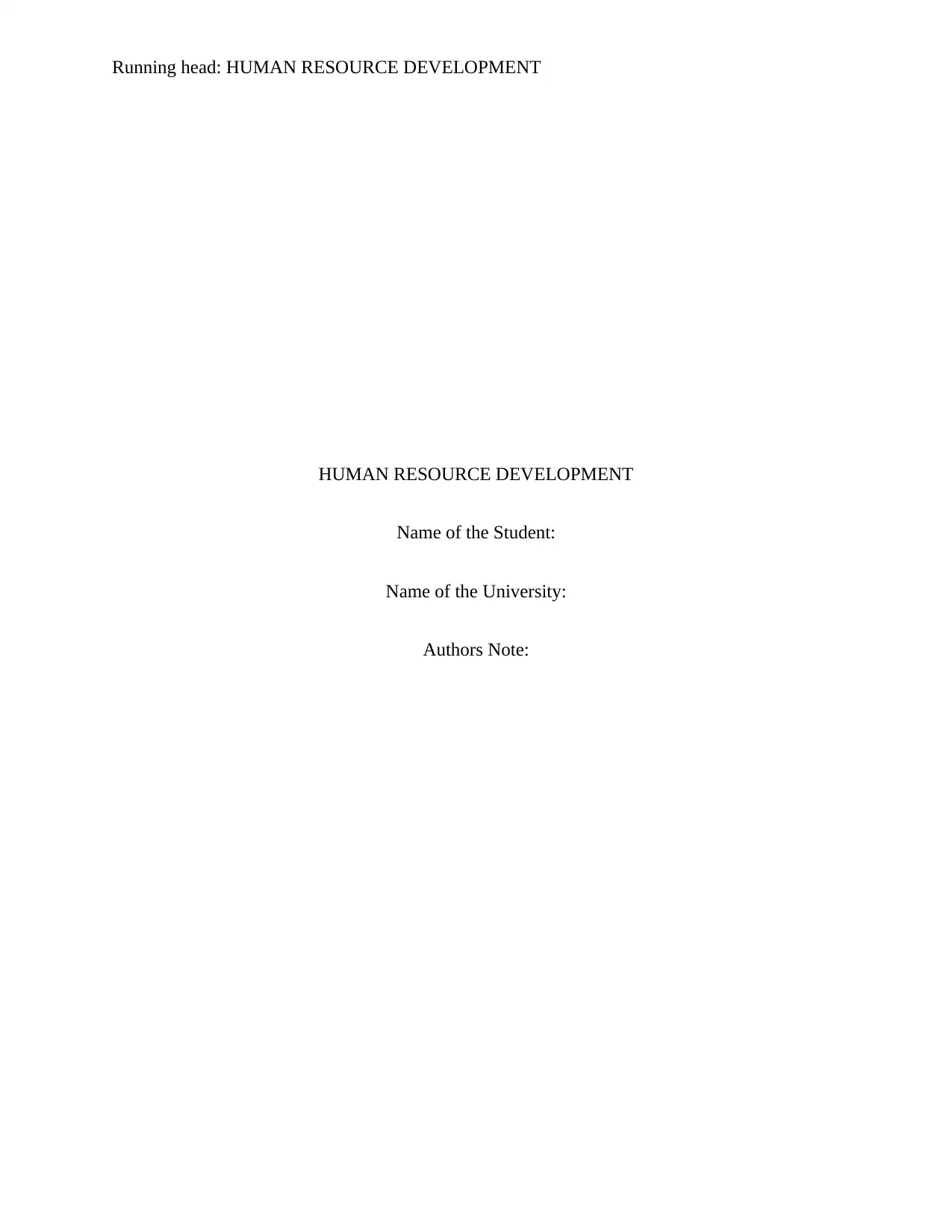
Running head: HUMAN RESOURCE DEVELOPMENT
HUMAN RESOURCE DEVELOPMENT
Name of the Student:
Name of the University:
Authors Note:
HUMAN RESOURCE DEVELOPMENT
Name of the Student:
Name of the University:
Authors Note:
Paraphrase This Document
Need a fresh take? Get an instant paraphrase of this document with our AI Paraphraser
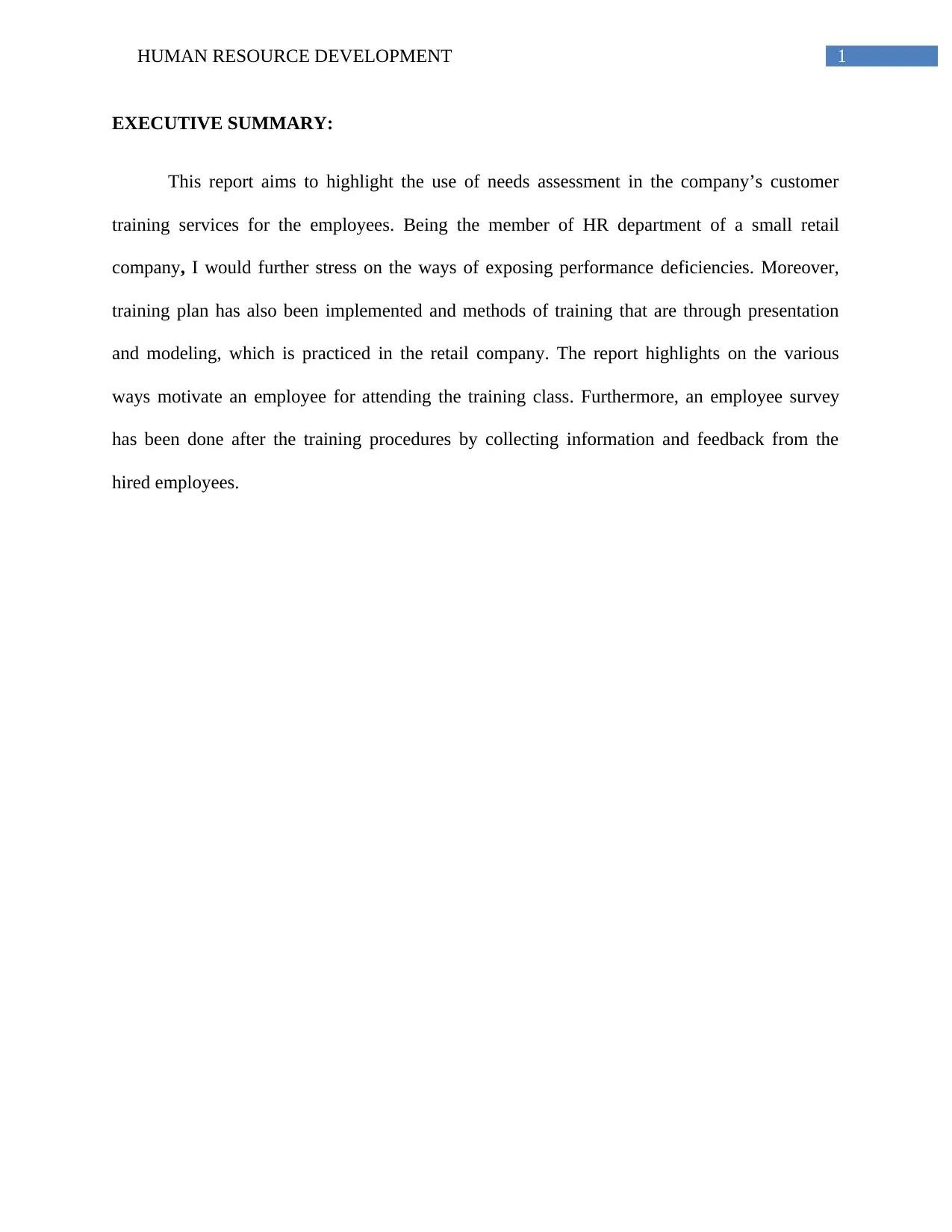
1HUMAN RESOURCE DEVELOPMENT
EXECUTIVE SUMMARY:
This report aims to highlight the use of needs assessment in the company’s customer
training services for the employees. Being the member of HR department of a small retail
company, I would further stress on the ways of exposing performance deficiencies. Moreover,
training plan has also been implemented and methods of training that are through presentation
and modeling, which is practiced in the retail company. The report highlights on the various
ways motivate an employee for attending the training class. Furthermore, an employee survey
has been done after the training procedures by collecting information and feedback from the
hired employees.
EXECUTIVE SUMMARY:
This report aims to highlight the use of needs assessment in the company’s customer
training services for the employees. Being the member of HR department of a small retail
company, I would further stress on the ways of exposing performance deficiencies. Moreover,
training plan has also been implemented and methods of training that are through presentation
and modeling, which is practiced in the retail company. The report highlights on the various
ways motivate an employee for attending the training class. Furthermore, an employee survey
has been done after the training procedures by collecting information and feedback from the
hired employees.
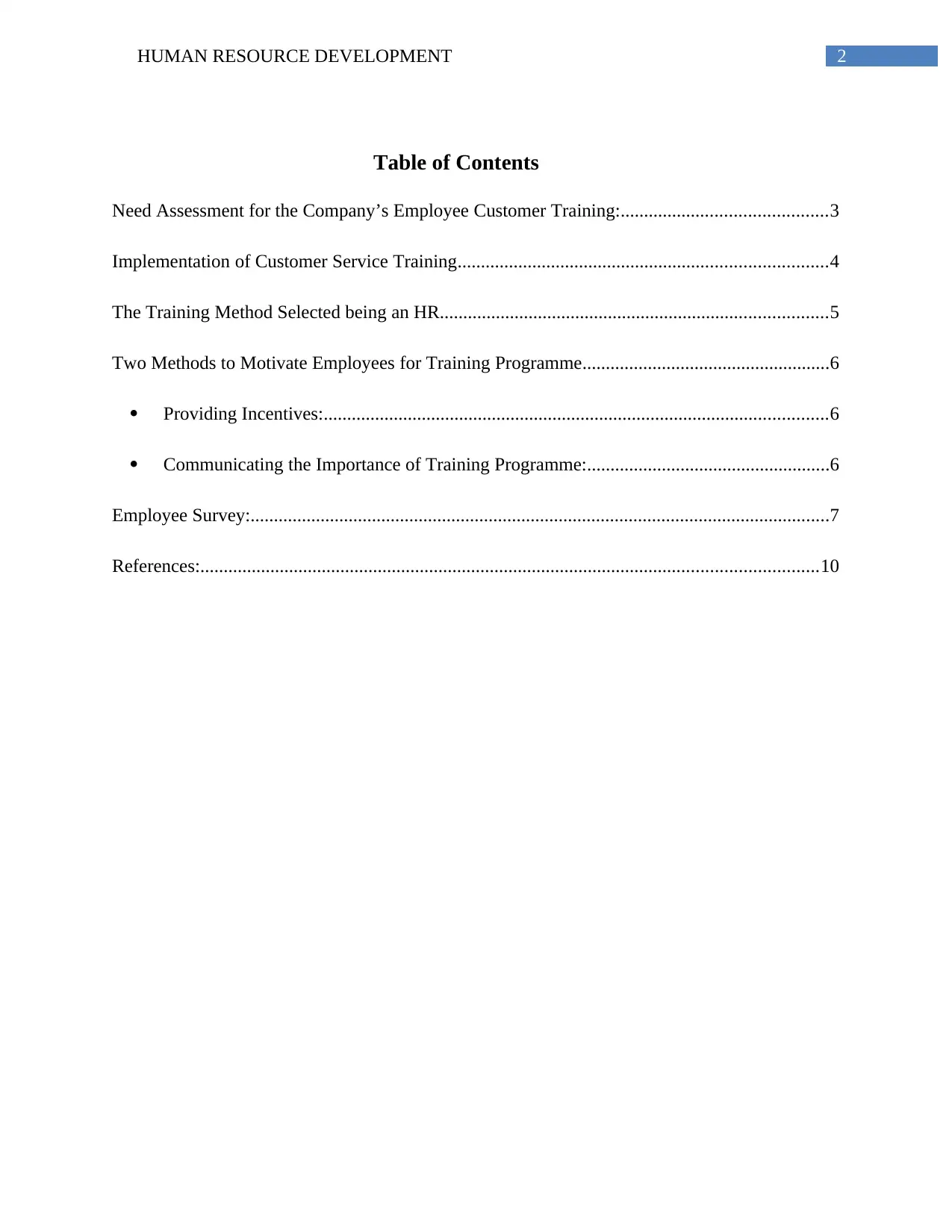
2HUMAN RESOURCE DEVELOPMENT
Table of Contents
Need Assessment for the Company’s Employee Customer Training:............................................3
Implementation of Customer Service Training...............................................................................4
The Training Method Selected being an HR...................................................................................5
Two Methods to Motivate Employees for Training Programme.....................................................6
Providing Incentives:............................................................................................................6
Communicating the Importance of Training Programme:....................................................6
Employee Survey:............................................................................................................................7
References:....................................................................................................................................10
Table of Contents
Need Assessment for the Company’s Employee Customer Training:............................................3
Implementation of Customer Service Training...............................................................................4
The Training Method Selected being an HR...................................................................................5
Two Methods to Motivate Employees for Training Programme.....................................................6
Providing Incentives:............................................................................................................6
Communicating the Importance of Training Programme:....................................................6
Employee Survey:............................................................................................................................7
References:....................................................................................................................................10
⊘ This is a preview!⊘
Do you want full access?
Subscribe today to unlock all pages.

Trusted by 1+ million students worldwide
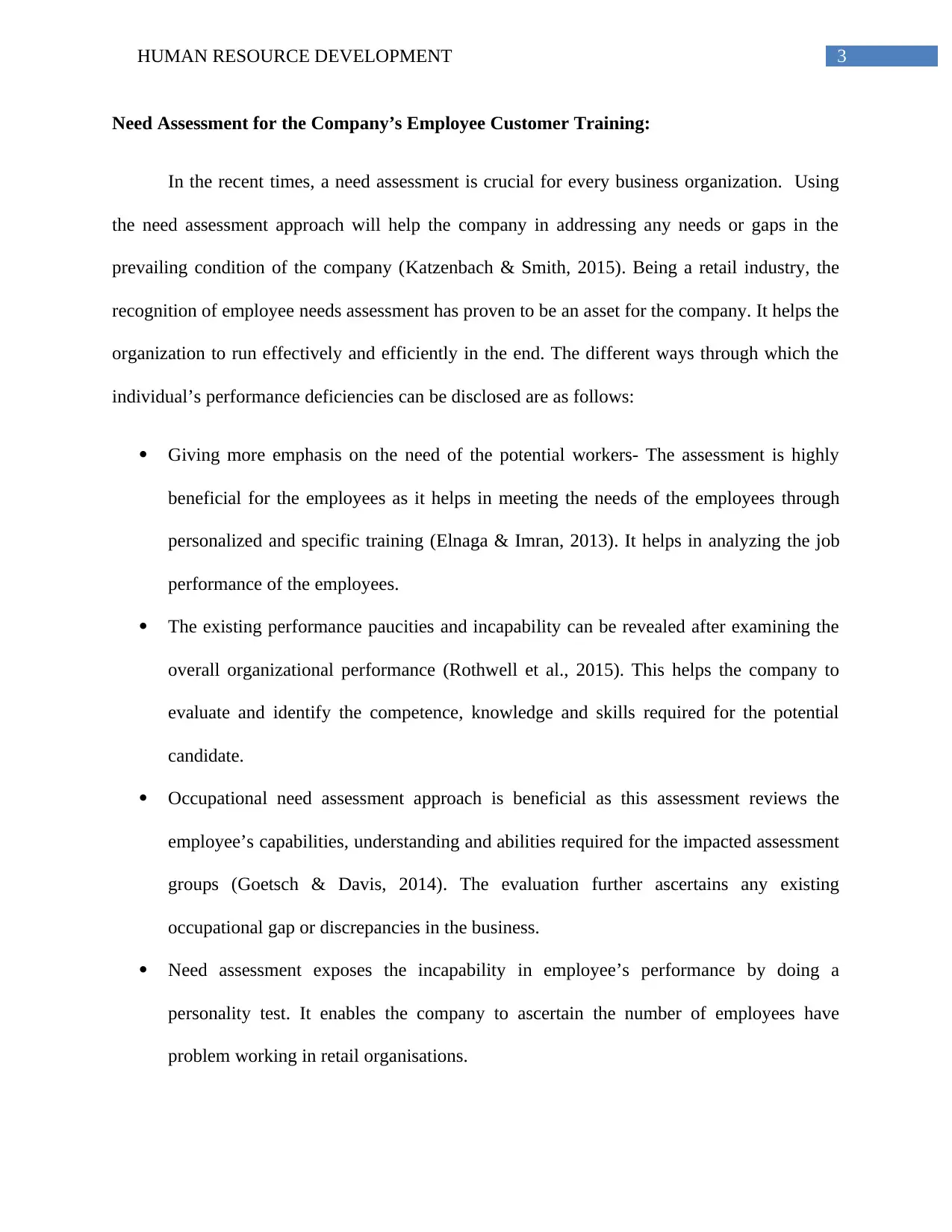
3HUMAN RESOURCE DEVELOPMENT
Need Assessment for the Company’s Employee Customer Training:
In the recent times, a need assessment is crucial for every business organization. Using
the need assessment approach will help the company in addressing any needs or gaps in the
prevailing condition of the company (Katzenbach & Smith, 2015). Being a retail industry, the
recognition of employee needs assessment has proven to be an asset for the company. It helps the
organization to run effectively and efficiently in the end. The different ways through which the
individual’s performance deficiencies can be disclosed are as follows:
Giving more emphasis on the need of the potential workers- The assessment is highly
beneficial for the employees as it helps in meeting the needs of the employees through
personalized and specific training (Elnaga & Imran, 2013). It helps in analyzing the job
performance of the employees.
The existing performance paucities and incapability can be revealed after examining the
overall organizational performance (Rothwell et al., 2015). This helps the company to
evaluate and identify the competence, knowledge and skills required for the potential
candidate.
Occupational need assessment approach is beneficial as this assessment reviews the
employee’s capabilities, understanding and abilities required for the impacted assessment
groups (Goetsch & Davis, 2014). The evaluation further ascertains any existing
occupational gap or discrepancies in the business.
Need assessment exposes the incapability in employee’s performance by doing a
personality test. It enables the company to ascertain the number of employees have
problem working in retail organisations.
Need Assessment for the Company’s Employee Customer Training:
In the recent times, a need assessment is crucial for every business organization. Using
the need assessment approach will help the company in addressing any needs or gaps in the
prevailing condition of the company (Katzenbach & Smith, 2015). Being a retail industry, the
recognition of employee needs assessment has proven to be an asset for the company. It helps the
organization to run effectively and efficiently in the end. The different ways through which the
individual’s performance deficiencies can be disclosed are as follows:
Giving more emphasis on the need of the potential workers- The assessment is highly
beneficial for the employees as it helps in meeting the needs of the employees through
personalized and specific training (Elnaga & Imran, 2013). It helps in analyzing the job
performance of the employees.
The existing performance paucities and incapability can be revealed after examining the
overall organizational performance (Rothwell et al., 2015). This helps the company to
evaluate and identify the competence, knowledge and skills required for the potential
candidate.
Occupational need assessment approach is beneficial as this assessment reviews the
employee’s capabilities, understanding and abilities required for the impacted assessment
groups (Goetsch & Davis, 2014). The evaluation further ascertains any existing
occupational gap or discrepancies in the business.
Need assessment exposes the incapability in employee’s performance by doing a
personality test. It enables the company to ascertain the number of employees have
problem working in retail organisations.
Paraphrase This Document
Need a fresh take? Get an instant paraphrase of this document with our AI Paraphraser
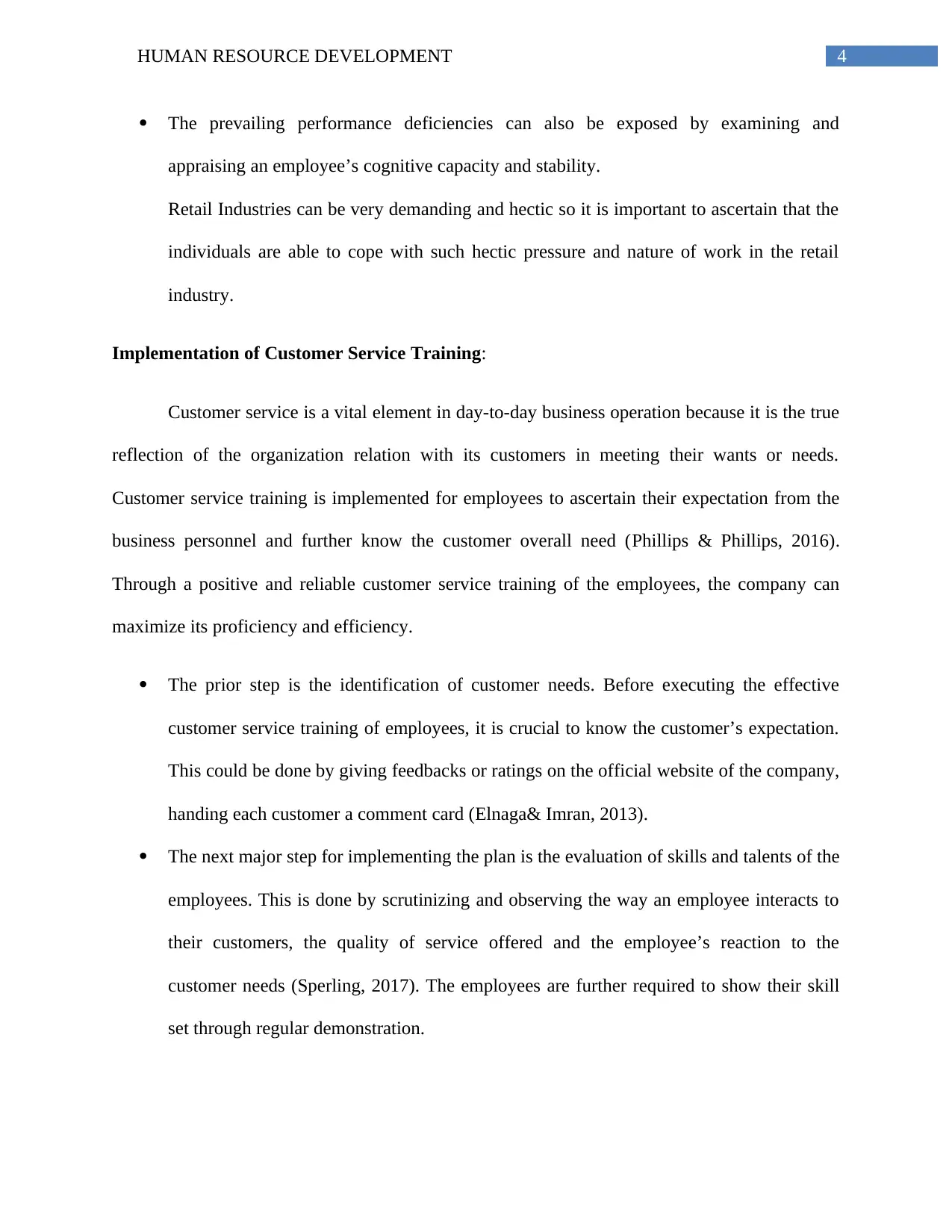
4HUMAN RESOURCE DEVELOPMENT
The prevailing performance deficiencies can also be exposed by examining and
appraising an employee’s cognitive capacity and stability.
Retail Industries can be very demanding and hectic so it is important to ascertain that the
individuals are able to cope with such hectic pressure and nature of work in the retail
industry.
Implementation of Customer Service Training:
Customer service is a vital element in day-to-day business operation because it is the true
reflection of the organization relation with its customers in meeting their wants or needs.
Customer service training is implemented for employees to ascertain their expectation from the
business personnel and further know the customer overall need (Phillips & Phillips, 2016).
Through a positive and reliable customer service training of the employees, the company can
maximize its proficiency and efficiency.
The prior step is the identification of customer needs. Before executing the effective
customer service training of employees, it is crucial to know the customer’s expectation.
This could be done by giving feedbacks or ratings on the official website of the company,
handing each customer a comment card (Elnaga& Imran, 2013).
The next major step for implementing the plan is the evaluation of skills and talents of the
employees. This is done by scrutinizing and observing the way an employee interacts to
their customers, the quality of service offered and the employee’s reaction to the
customer needs (Sperling, 2017). The employees are further required to show their skill
set through regular demonstration.
The prevailing performance deficiencies can also be exposed by examining and
appraising an employee’s cognitive capacity and stability.
Retail Industries can be very demanding and hectic so it is important to ascertain that the
individuals are able to cope with such hectic pressure and nature of work in the retail
industry.
Implementation of Customer Service Training:
Customer service is a vital element in day-to-day business operation because it is the true
reflection of the organization relation with its customers in meeting their wants or needs.
Customer service training is implemented for employees to ascertain their expectation from the
business personnel and further know the customer overall need (Phillips & Phillips, 2016).
Through a positive and reliable customer service training of the employees, the company can
maximize its proficiency and efficiency.
The prior step is the identification of customer needs. Before executing the effective
customer service training of employees, it is crucial to know the customer’s expectation.
This could be done by giving feedbacks or ratings on the official website of the company,
handing each customer a comment card (Elnaga& Imran, 2013).
The next major step for implementing the plan is the evaluation of skills and talents of the
employees. This is done by scrutinizing and observing the way an employee interacts to
their customers, the quality of service offered and the employee’s reaction to the
customer needs (Sperling, 2017). The employees are further required to show their skill
set through regular demonstration.
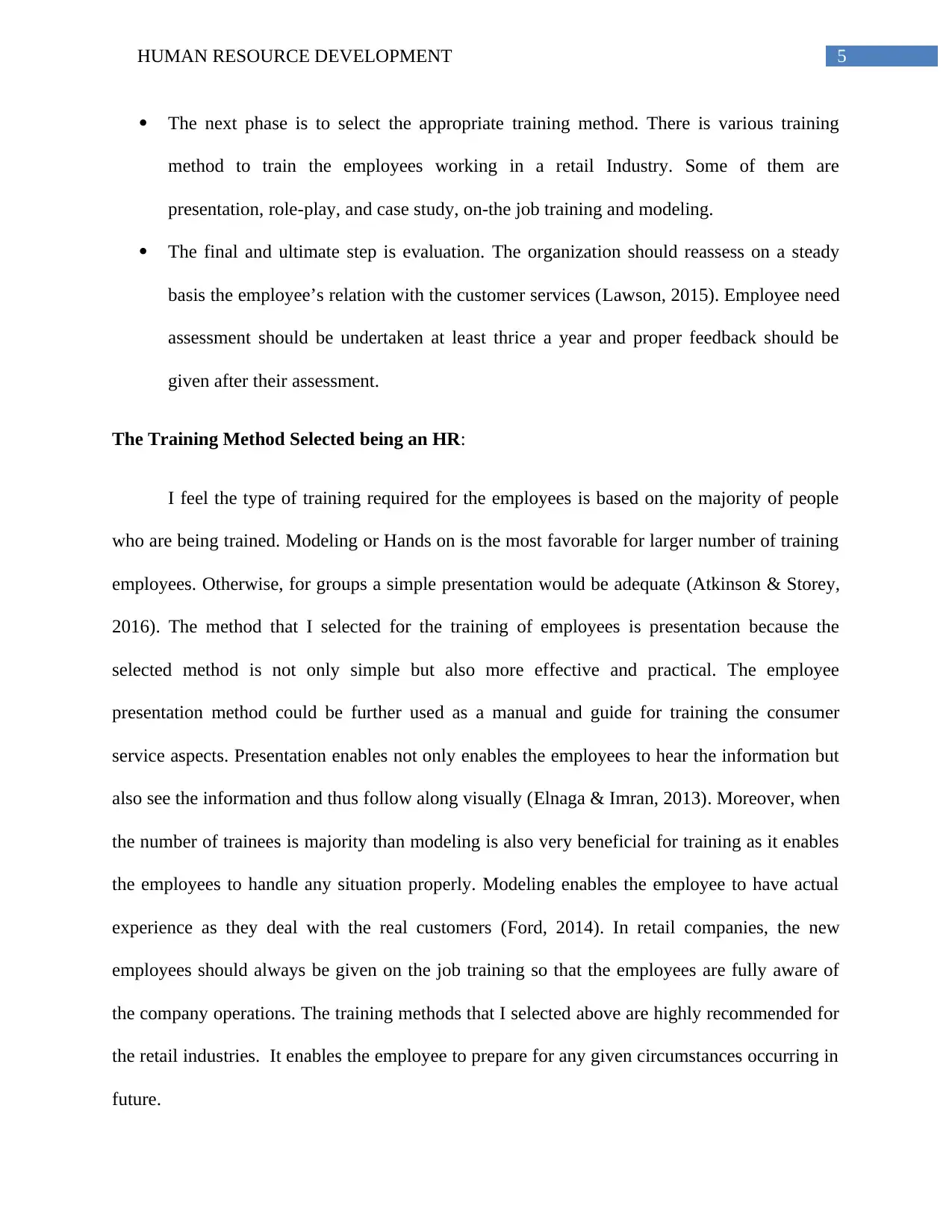
5HUMAN RESOURCE DEVELOPMENT
The next phase is to select the appropriate training method. There is various training
method to train the employees working in a retail Industry. Some of them are
presentation, role-play, and case study, on-the job training and modeling.
The final and ultimate step is evaluation. The organization should reassess on a steady
basis the employee’s relation with the customer services (Lawson, 2015). Employee need
assessment should be undertaken at least thrice a year and proper feedback should be
given after their assessment.
The Training Method Selected being an HR:
I feel the type of training required for the employees is based on the majority of people
who are being trained. Modeling or Hands on is the most favorable for larger number of training
employees. Otherwise, for groups a simple presentation would be adequate (Atkinson & Storey,
2016). The method that I selected for the training of employees is presentation because the
selected method is not only simple but also more effective and practical. The employee
presentation method could be further used as a manual and guide for training the consumer
service aspects. Presentation enables not only enables the employees to hear the information but
also see the information and thus follow along visually (Elnaga & Imran, 2013). Moreover, when
the number of trainees is majority than modeling is also very beneficial for training as it enables
the employees to handle any situation properly. Modeling enables the employee to have actual
experience as they deal with the real customers (Ford, 2014). In retail companies, the new
employees should always be given on the job training so that the employees are fully aware of
the company operations. The training methods that I selected above are highly recommended for
the retail industries. It enables the employee to prepare for any given circumstances occurring in
future.
The next phase is to select the appropriate training method. There is various training
method to train the employees working in a retail Industry. Some of them are
presentation, role-play, and case study, on-the job training and modeling.
The final and ultimate step is evaluation. The organization should reassess on a steady
basis the employee’s relation with the customer services (Lawson, 2015). Employee need
assessment should be undertaken at least thrice a year and proper feedback should be
given after their assessment.
The Training Method Selected being an HR:
I feel the type of training required for the employees is based on the majority of people
who are being trained. Modeling or Hands on is the most favorable for larger number of training
employees. Otherwise, for groups a simple presentation would be adequate (Atkinson & Storey,
2016). The method that I selected for the training of employees is presentation because the
selected method is not only simple but also more effective and practical. The employee
presentation method could be further used as a manual and guide for training the consumer
service aspects. Presentation enables not only enables the employees to hear the information but
also see the information and thus follow along visually (Elnaga & Imran, 2013). Moreover, when
the number of trainees is majority than modeling is also very beneficial for training as it enables
the employees to handle any situation properly. Modeling enables the employee to have actual
experience as they deal with the real customers (Ford, 2014). In retail companies, the new
employees should always be given on the job training so that the employees are fully aware of
the company operations. The training methods that I selected above are highly recommended for
the retail industries. It enables the employee to prepare for any given circumstances occurring in
future.
⊘ This is a preview!⊘
Do you want full access?
Subscribe today to unlock all pages.

Trusted by 1+ million students worldwide
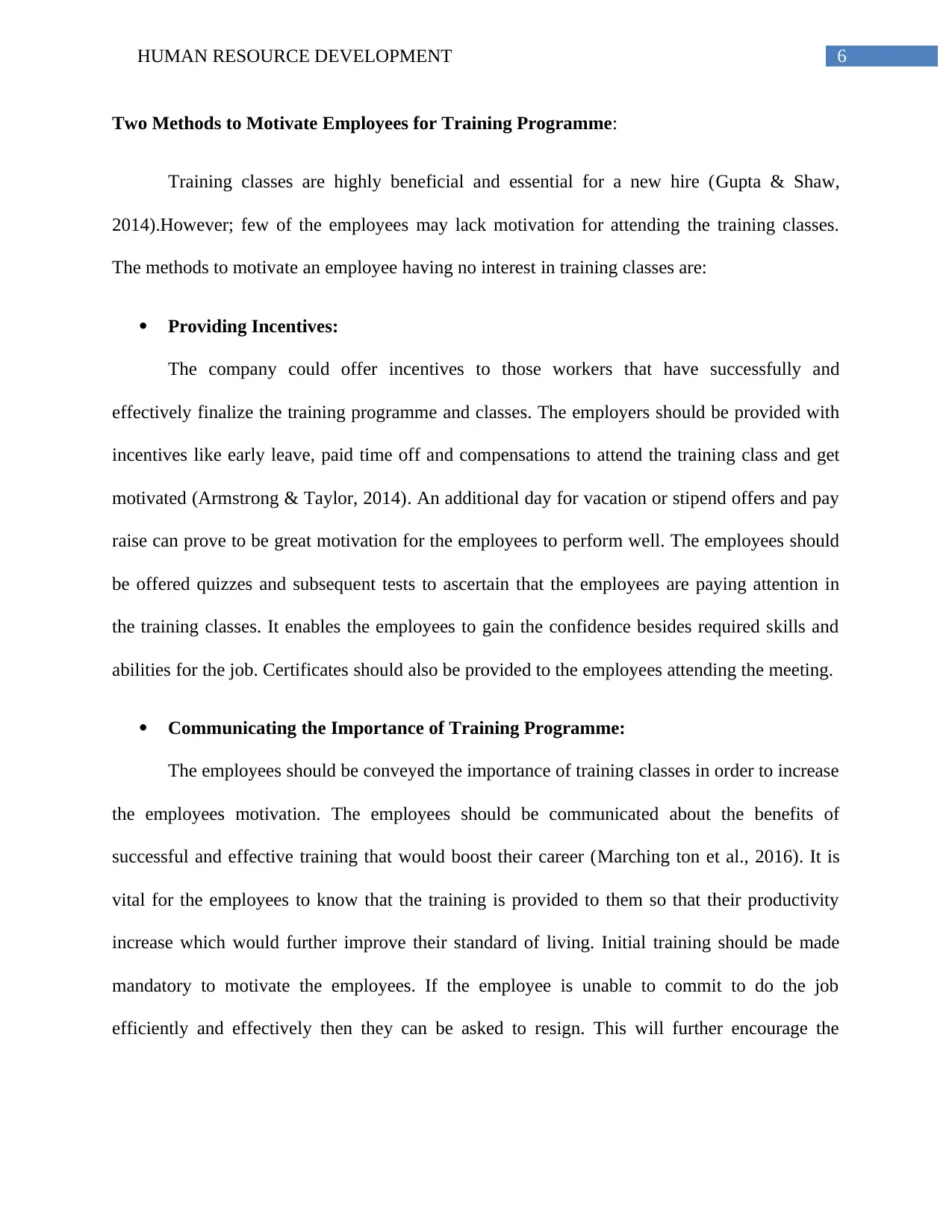
6HUMAN RESOURCE DEVELOPMENT
Two Methods to Motivate Employees for Training Programme:
Training classes are highly beneficial and essential for a new hire (Gupta & Shaw,
2014).However; few of the employees may lack motivation for attending the training classes.
The methods to motivate an employee having no interest in training classes are:
Providing Incentives:
The company could offer incentives to those workers that have successfully and
effectively finalize the training programme and classes. The employers should be provided with
incentives like early leave, paid time off and compensations to attend the training class and get
motivated (Armstrong & Taylor, 2014). An additional day for vacation or stipend offers and pay
raise can prove to be great motivation for the employees to perform well. The employees should
be offered quizzes and subsequent tests to ascertain that the employees are paying attention in
the training classes. It enables the employees to gain the confidence besides required skills and
abilities for the job. Certificates should also be provided to the employees attending the meeting.
Communicating the Importance of Training Programme:
The employees should be conveyed the importance of training classes in order to increase
the employees motivation. The employees should be communicated about the benefits of
successful and effective training that would boost their career (Marching ton et al., 2016). It is
vital for the employees to know that the training is provided to them so that their productivity
increase which would further improve their standard of living. Initial training should be made
mandatory to motivate the employees. If the employee is unable to commit to do the job
efficiently and effectively then they can be asked to resign. This will further encourage the
Two Methods to Motivate Employees for Training Programme:
Training classes are highly beneficial and essential for a new hire (Gupta & Shaw,
2014).However; few of the employees may lack motivation for attending the training classes.
The methods to motivate an employee having no interest in training classes are:
Providing Incentives:
The company could offer incentives to those workers that have successfully and
effectively finalize the training programme and classes. The employers should be provided with
incentives like early leave, paid time off and compensations to attend the training class and get
motivated (Armstrong & Taylor, 2014). An additional day for vacation or stipend offers and pay
raise can prove to be great motivation for the employees to perform well. The employees should
be offered quizzes and subsequent tests to ascertain that the employees are paying attention in
the training classes. It enables the employees to gain the confidence besides required skills and
abilities for the job. Certificates should also be provided to the employees attending the meeting.
Communicating the Importance of Training Programme:
The employees should be conveyed the importance of training classes in order to increase
the employees motivation. The employees should be communicated about the benefits of
successful and effective training that would boost their career (Marching ton et al., 2016). It is
vital for the employees to know that the training is provided to them so that their productivity
increase which would further improve their standard of living. Initial training should be made
mandatory to motivate the employees. If the employee is unable to commit to do the job
efficiently and effectively then they can be asked to resign. This will further encourage the
Paraphrase This Document
Need a fresh take? Get an instant paraphrase of this document with our AI Paraphraser
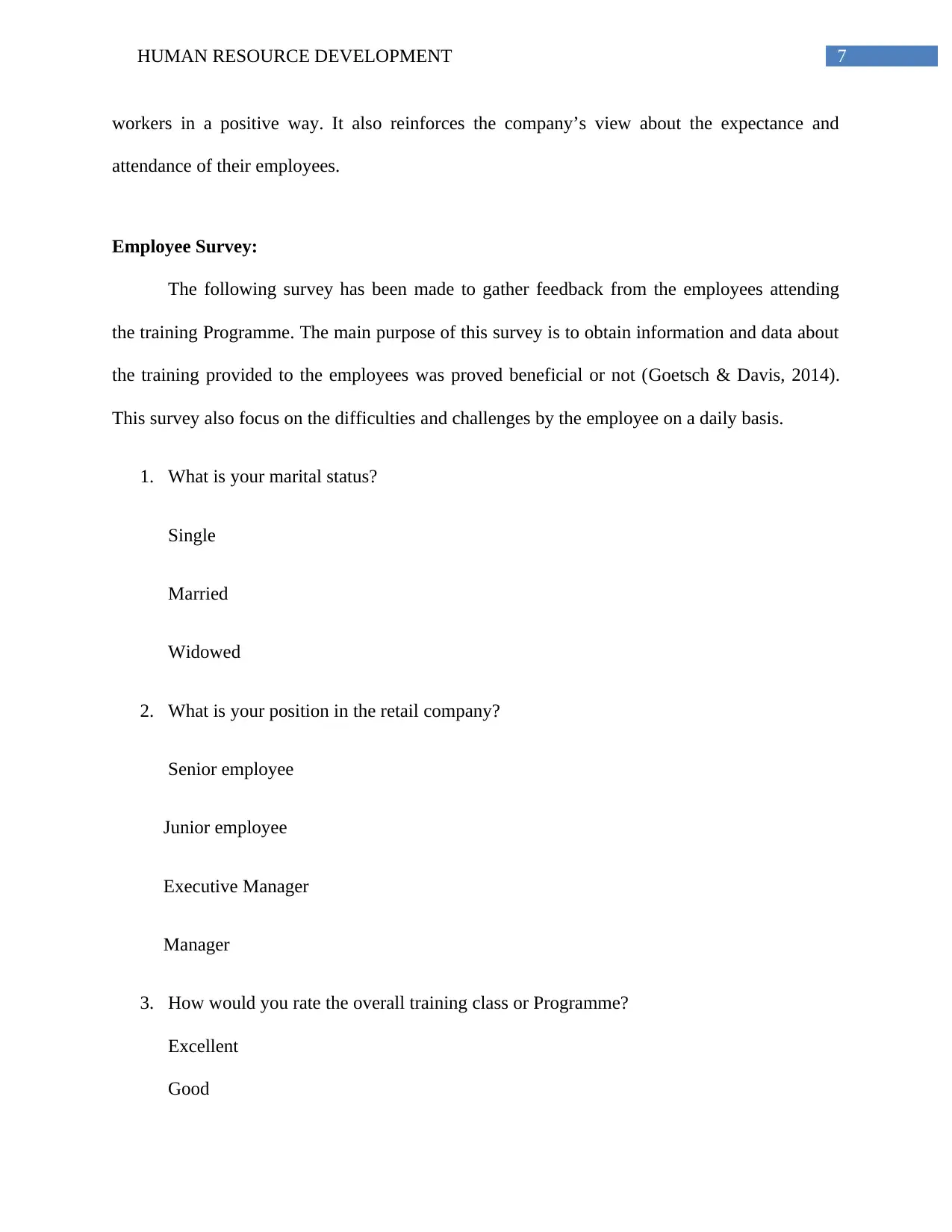
7HUMAN RESOURCE DEVELOPMENT
workers in a positive way. It also reinforces the company’s view about the expectance and
attendance of their employees.
Employee Survey:
The following survey has been made to gather feedback from the employees attending
the training Programme. The main purpose of this survey is to obtain information and data about
the training provided to the employees was proved beneficial or not (Goetsch & Davis, 2014).
This survey also focus on the difficulties and challenges by the employee on a daily basis.
1. What is your marital status?
Single
Married
Widowed
2. What is your position in the retail company?
Senior employee
Junior employee
Executive Manager
Manager
3. How would you rate the overall training class or Programme?
Excellent
Good
workers in a positive way. It also reinforces the company’s view about the expectance and
attendance of their employees.
Employee Survey:
The following survey has been made to gather feedback from the employees attending
the training Programme. The main purpose of this survey is to obtain information and data about
the training provided to the employees was proved beneficial or not (Goetsch & Davis, 2014).
This survey also focus on the difficulties and challenges by the employee on a daily basis.
1. What is your marital status?
Single
Married
Widowed
2. What is your position in the retail company?
Senior employee
Junior employee
Executive Manager
Manager
3. How would you rate the overall training class or Programme?
Excellent
Good
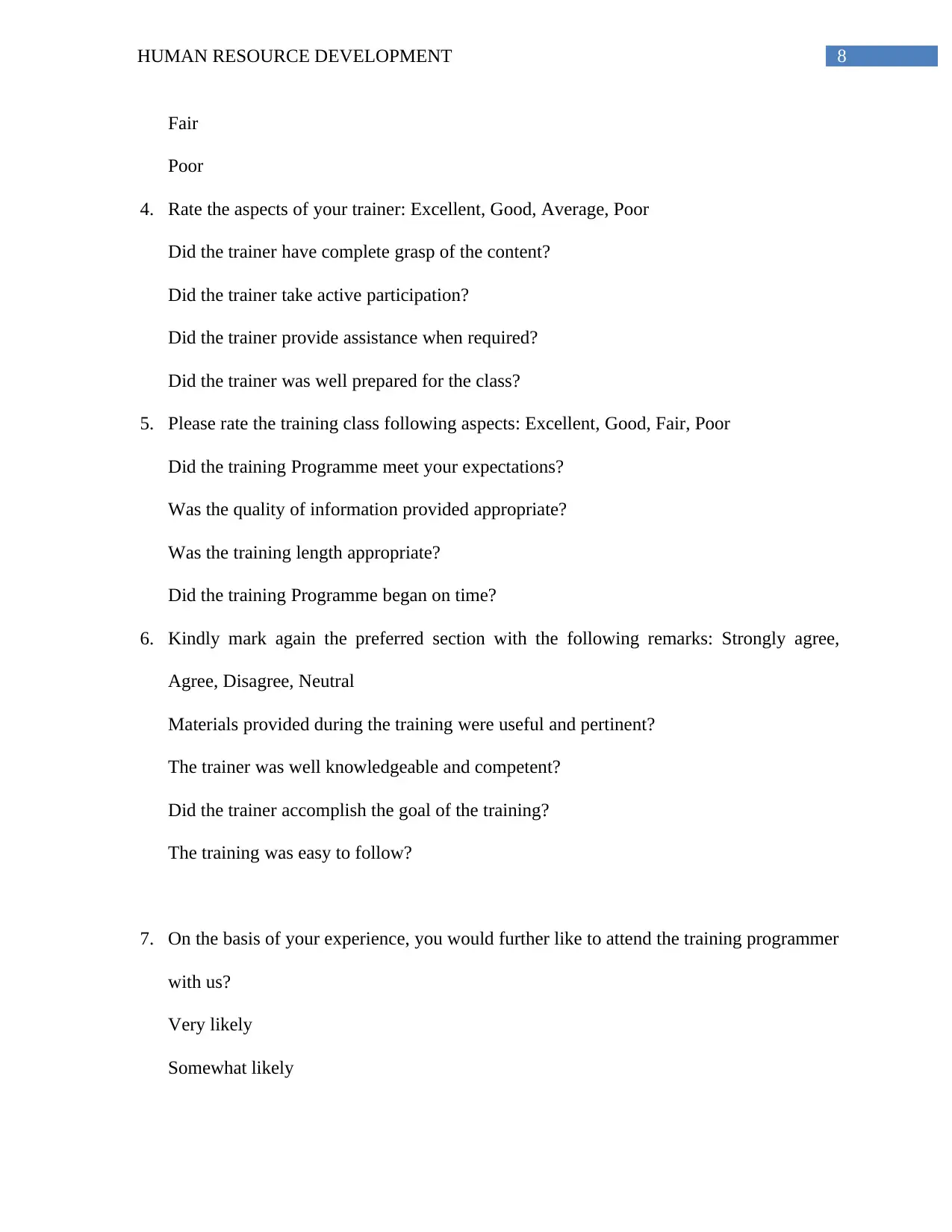
8HUMAN RESOURCE DEVELOPMENT
Fair
Poor
4. Rate the aspects of your trainer: Excellent, Good, Average, Poor
Did the trainer have complete grasp of the content?
Did the trainer take active participation?
Did the trainer provide assistance when required?
Did the trainer was well prepared for the class?
5. Please rate the training class following aspects: Excellent, Good, Fair, Poor
Did the training Programme meet your expectations?
Was the quality of information provided appropriate?
Was the training length appropriate?
Did the training Programme began on time?
6. Kindly mark again the preferred section with the following remarks: Strongly agree,
Agree, Disagree, Neutral
Materials provided during the training were useful and pertinent?
The trainer was well knowledgeable and competent?
Did the trainer accomplish the goal of the training?
The training was easy to follow?
7. On the basis of your experience, you would further like to attend the training programmer
with us?
Very likely
Somewhat likely
Fair
Poor
4. Rate the aspects of your trainer: Excellent, Good, Average, Poor
Did the trainer have complete grasp of the content?
Did the trainer take active participation?
Did the trainer provide assistance when required?
Did the trainer was well prepared for the class?
5. Please rate the training class following aspects: Excellent, Good, Fair, Poor
Did the training Programme meet your expectations?
Was the quality of information provided appropriate?
Was the training length appropriate?
Did the training Programme began on time?
6. Kindly mark again the preferred section with the following remarks: Strongly agree,
Agree, Disagree, Neutral
Materials provided during the training were useful and pertinent?
The trainer was well knowledgeable and competent?
Did the trainer accomplish the goal of the training?
The training was easy to follow?
7. On the basis of your experience, you would further like to attend the training programmer
with us?
Very likely
Somewhat likely
⊘ This is a preview!⊘
Do you want full access?
Subscribe today to unlock all pages.

Trusted by 1+ million students worldwide
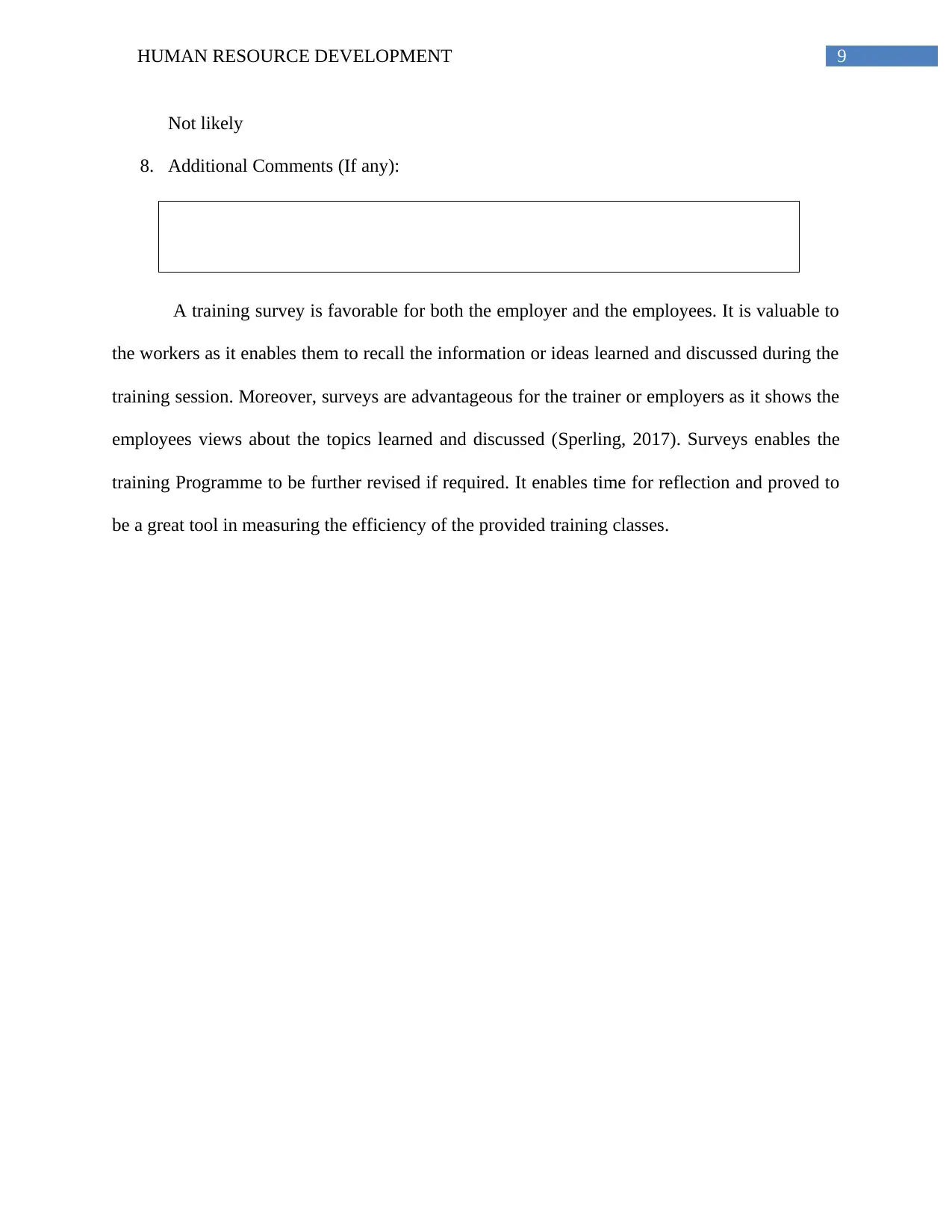
9HUMAN RESOURCE DEVELOPMENT
Not likely
8. Additional Comments (If any):
A training survey is favorable for both the employer and the employees. It is valuable to
the workers as it enables them to recall the information or ideas learned and discussed during the
training session. Moreover, surveys are advantageous for the trainer or employers as it shows the
employees views about the topics learned and discussed (Sperling, 2017). Surveys enables the
training Programme to be further revised if required. It enables time for reflection and proved to
be a great tool in measuring the efficiency of the provided training classes.
Not likely
8. Additional Comments (If any):
A training survey is favorable for both the employer and the employees. It is valuable to
the workers as it enables them to recall the information or ideas learned and discussed during the
training session. Moreover, surveys are advantageous for the trainer or employers as it shows the
employees views about the topics learned and discussed (Sperling, 2017). Surveys enables the
training Programme to be further revised if required. It enables time for reflection and proved to
be a great tool in measuring the efficiency of the provided training classes.
Paraphrase This Document
Need a fresh take? Get an instant paraphrase of this document with our AI Paraphraser
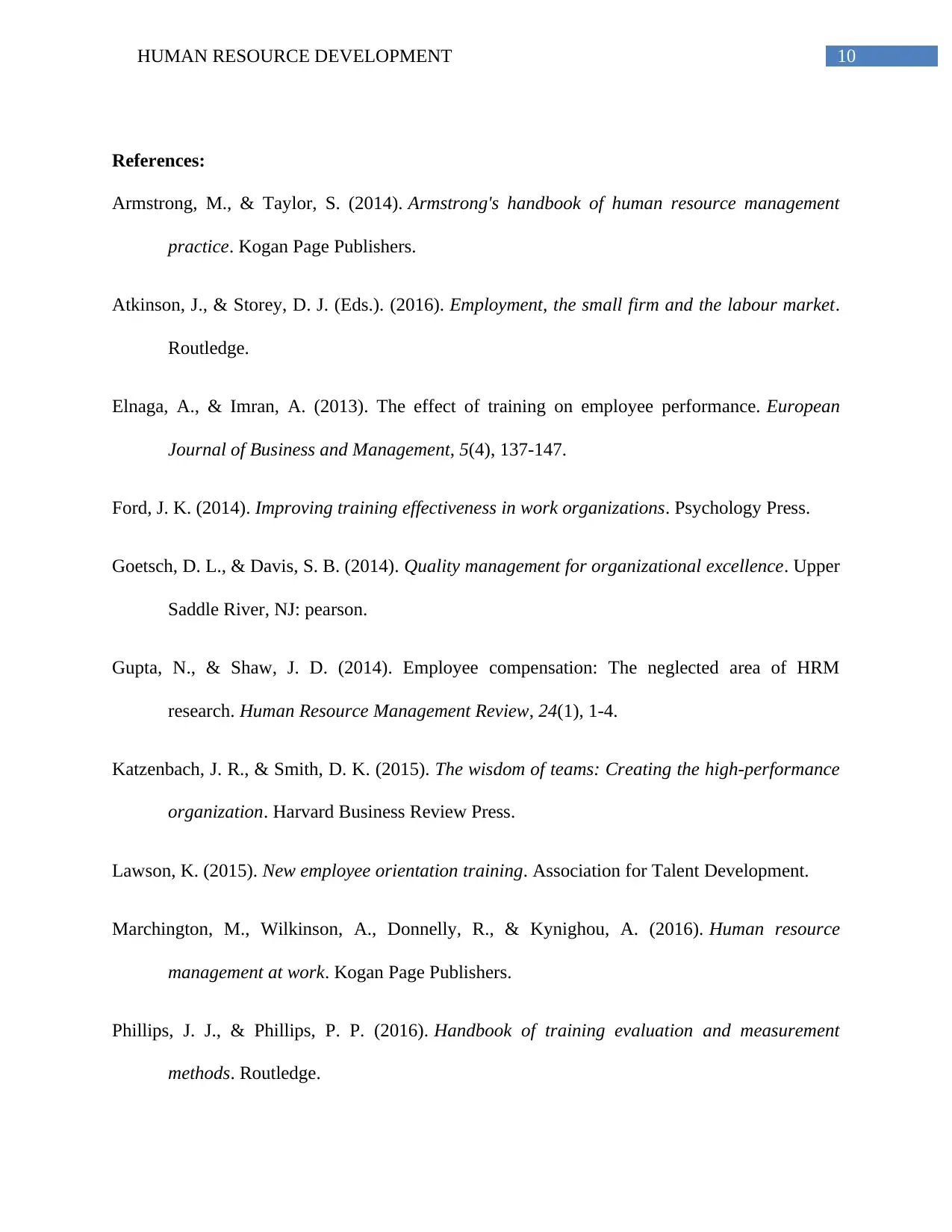
10HUMAN RESOURCE DEVELOPMENT
References:
Armstrong, M., & Taylor, S. (2014). Armstrong's handbook of human resource management
practice. Kogan Page Publishers.
Atkinson, J., & Storey, D. J. (Eds.). (2016). Employment, the small firm and the labour market.
Routledge.
Elnaga, A., & Imran, A. (2013). The effect of training on employee performance. European
Journal of Business and Management, 5(4), 137-147.
Ford, J. K. (2014). Improving training effectiveness in work organizations. Psychology Press.
Goetsch, D. L., & Davis, S. B. (2014). Quality management for organizational excellence. Upper
Saddle River, NJ: pearson.
Gupta, N., & Shaw, J. D. (2014). Employee compensation: The neglected area of HRM
research. Human Resource Management Review, 24(1), 1-4.
Katzenbach, J. R., & Smith, D. K. (2015). The wisdom of teams: Creating the high-performance
organization. Harvard Business Review Press.
Lawson, K. (2015). New employee orientation training. Association for Talent Development.
Marchington, M., Wilkinson, A., Donnelly, R., & Kynighou, A. (2016). Human resource
management at work. Kogan Page Publishers.
Phillips, J. J., & Phillips, P. P. (2016). Handbook of training evaluation and measurement
methods. Routledge.
References:
Armstrong, M., & Taylor, S. (2014). Armstrong's handbook of human resource management
practice. Kogan Page Publishers.
Atkinson, J., & Storey, D. J. (Eds.). (2016). Employment, the small firm and the labour market.
Routledge.
Elnaga, A., & Imran, A. (2013). The effect of training on employee performance. European
Journal of Business and Management, 5(4), 137-147.
Ford, J. K. (2014). Improving training effectiveness in work organizations. Psychology Press.
Goetsch, D. L., & Davis, S. B. (2014). Quality management for organizational excellence. Upper
Saddle River, NJ: pearson.
Gupta, N., & Shaw, J. D. (2014). Employee compensation: The neglected area of HRM
research. Human Resource Management Review, 24(1), 1-4.
Katzenbach, J. R., & Smith, D. K. (2015). The wisdom of teams: Creating the high-performance
organization. Harvard Business Review Press.
Lawson, K. (2015). New employee orientation training. Association for Talent Development.
Marchington, M., Wilkinson, A., Donnelly, R., & Kynighou, A. (2016). Human resource
management at work. Kogan Page Publishers.
Phillips, J. J., & Phillips, P. P. (2016). Handbook of training evaluation and measurement
methods. Routledge.
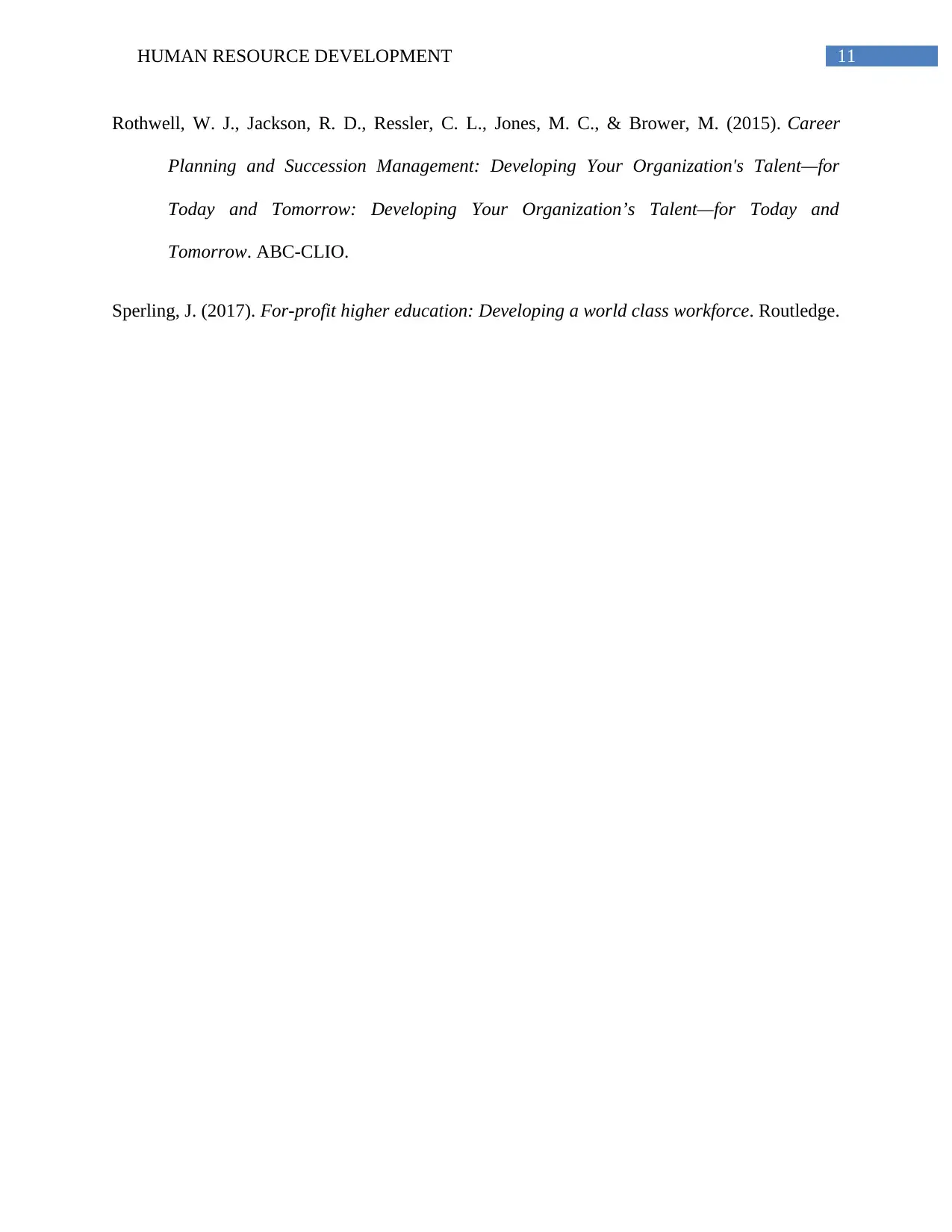
11HUMAN RESOURCE DEVELOPMENT
Rothwell, W. J., Jackson, R. D., Ressler, C. L., Jones, M. C., & Brower, M. (2015). Career
Planning and Succession Management: Developing Your Organization's Talent—for
Today and Tomorrow: Developing Your Organization’s Talent—for Today and
Tomorrow. ABC-CLIO.
Sperling, J. (2017). For-profit higher education: Developing a world class workforce. Routledge.
Rothwell, W. J., Jackson, R. D., Ressler, C. L., Jones, M. C., & Brower, M. (2015). Career
Planning and Succession Management: Developing Your Organization's Talent—for
Today and Tomorrow: Developing Your Organization’s Talent—for Today and
Tomorrow. ABC-CLIO.
Sperling, J. (2017). For-profit higher education: Developing a world class workforce. Routledge.
⊘ This is a preview!⊘
Do you want full access?
Subscribe today to unlock all pages.

Trusted by 1+ million students worldwide
1 out of 12
Related Documents
Your All-in-One AI-Powered Toolkit for Academic Success.
+13062052269
info@desklib.com
Available 24*7 on WhatsApp / Email
![[object Object]](/_next/static/media/star-bottom.7253800d.svg)
Unlock your academic potential
Copyright © 2020–2025 A2Z Services. All Rights Reserved. Developed and managed by ZUCOL.





